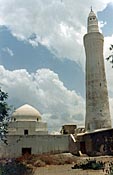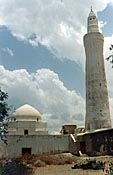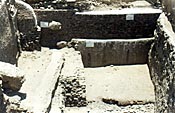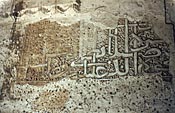
Secrets of Zabeed’s Al-Iskandaria (Alexandria) Mosque [Archives:1999/22/Culture]
May 31 1999

While touring the city, I met Mr. Abdul Habib Mohammed Farea Al-Dobhani, a specialist in archaeology, who is the counterpart of the Canadian team. Mr. Al-Dobhani is in charge of the city’s antiquities.
As he was well-informed on the history of the city, he was asked by Saleh Abdulbaqi, Cultural Editor of Yemen Times, a few questions about the city.

A: I am in charge of the archaeological and historic sites of the city of Zabeed. I also represent the Antiquities Committee and serve as counterpart to the Canadian archaeologic team. I have cooperated with them for the past ten years in the maintenance of these historic landmarks.
Q: We would like to know more about the mosque inside the fort?
A: This is a monumental landmark known as the Iskandar Mosque in reference to one of the Ottoman commanders who came to rule Yemen. In fact, this mosque was not Turkish, as it was built by the dynasties predating the Ottoman colonization of Yemen.
This fact was discovered last year by the Canadian team, from the scriptures and colored ornaments inside the dome. They have completed repairing part of the corner of the north west section as a model on which to proceed with the repair work of the whole mosque. They will also repair the colorful ornaments, calligraphy, and the scriptures inside the mosque.
Q: What is the most important part of the mosque in terms of historic relevance?
A: While we were repairing in the right and left parts of the prayer altar of the mosque, we found two marble pieces which had already been once repaired during the days of the Ottoman empire. Those pieces of marble are part of the evidence that the mosque belongs to the time of the Yemeni dynasties and thus pre-dates the Ottoman period. We also found other masterpieces like the ornaments inside the prayer altar.
Q: What do the scriptures on the sides of the mosque walls and domes say?

At the beginning of last year, the team started to repair some of the northern front part of the prayer house in the mosque. This was of two types, the
colored ornaments and the engraved ornaments. In addition, there are the marble ornaments which are inside the prayer altar. All these are considered to be a major part of the mosque. Further repair work will be performed over the next couple of years.
Q: Have you discovered any new things during your excavations inside the fort?
A: During the past four years of repairs and excavation, we found many parts of destroyed buildings underneath the fort. This was because Zabeed or Tihama had many wars in the past which destroyed the towns.
Generally these forts did not have any foundations, as we can see today in recent excavations. The constructions were made on the same ground, either directly over the destroyed buildings, or on the sand immediately around that area. Some of the destroyed parts remain there under the new the buildings. And during our excavations 7 meters under the fort we found water pipes. From this we discovered that the pipes in old constructions were located under ground, and as the years pass these pipes get buried further and further because of foundations which were lacking at that time, 700 years ago. I would like to add that eastern front gate was totally destroyed, with the ceiling and almost every thing buried before the excavation of the fort.
Q: How often do tourists visit this site?
A: Well, tourists visit the region of Zabeed very often, but it varies from season to season. During the summer, when the temperature is around 28-29 degrees Celsius it becomes difficult for the tourists to come here because we don’t have any rest houses here. That’s why the general committee has constructed the Zabeed rest house, which was supervised by Mr. Usama Al-Hadrami, and the tourists stay for a short period and return to Hodeidah or Al-Garahi. I think that business men could benefit if they constructed a hotel in the region of Zabeed. He would solve the residential problem. and increase the number of tourists visiting Zabeed.
Q: Do you have any plans for constructing a museum and exhibiting the things you discovered?
A: Yes, after excavation and discovering the cities buried under the fort, we will have a section inside the fort devoted to exhibiting our discoveries. Photos will also be taken, which will be shown to visitors.
Q: What are the obstacles that you face?
A: We have many obstacles. On the subject of the museum, we may need an appropriate hall for exhibition which is up to high standards for the tourists to see. Because of limited financial resources we are unable to build it. Allocations are very poor, and the monuments office does not help us in providing for 12000 rials in salary, and basic things such as water are not provided.
I personally hope that the office will take care of us and increase our salaries and provide us with the things we need to proceed with our daily work without any problems. Finally, we hope that the people in the office step forward to solve these problems.
——
[archive-e:22-v:1999-y:1999-d:1999-05-31-p:./1999/iss22/culture.htm]


